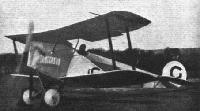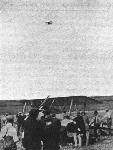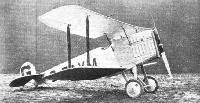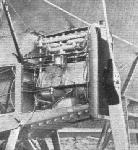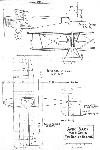
Описание
Страна : Великобритания
Год : 1919
Одноместный легкий самолет
Варианты
- Avro - Baby / Type 534 - 1919 - Великобритания
- Avro - Antarctic Baby / Type 554 - 1921 - Великобритания
- Southern - Martlet - 1929 - Великобритания
Avro серии 534 Baby
После Первой мировой войны фирма "A.V. Roe" разработала легкомоторный биплан Avro 534 Baby с двигателем Green мощностью 35 л. с. (26 кВт). Самолет впервые взлетел 30 апреля 1919 года, но всего через две минуты упал, поскольку пилот по небрежности выключил зажигание. Второй Baby полетел 10 мая 1919 года с двигателем, снятым с разбившегося самолета, и показал приемлемые характеристики. Одну машину использовала фирма "HG Leigh" для испытаний множественных аэродинамических поверхностей. Согласно документам, в Хэмбле построили девять экземпляров Baby, причем некоторые из них получили известность. Берт Хинклер выиграл на одной из машин Кубок Британии за перелет из Кройдона в Турин (1046 км) за 9,5 часов, еще один Baby в 1920 году выиграл "Воздушное дерби". Один самолет в 1922 году продали СССР, его перегонка стала первым полетом между Лондоном и Москвой. Дольше всех, вероятно, сохранился первый экземпляр, который перелетел в Австралию и числился в гражданском регистре страны до 1936 года.
Варианты
Avro 534A Water Baby: двухпоплавковый гидросамолет, полетел в октябре 1919 года, разбился в сентябре 1921 года
Avro 534B: имел обшитый фанерой фюзеляж и нижнее крыло уменьшенного размаха, разбился в августе 1920 года
Avro 534C: отличался крыльями уменьшенного размаха, строился для "Воздушного дерби" 1921 года, разбился в сентябре 1922 года
Avro 534D: специальный вариант с модификациями по заказу полковника Э. Виллиерса, использовавшего самолет для деловых поездок в окрестностях Калькутты до 1929 года
Avro 543: двухместный самолет с удлиненной на 0,76 м передней частью фюзеляжа, позднее установили двигатель A.D.C. Cirrus мощностью 60 л.с. (45 кВт), летал до 1934 года
Avro 554 Antarctic Baby: самолет для аэрофотосъемки на двух поплавках, построенный для экспедиции Шеклтона и Роуэтта в 1921 году, оснащался ротативным двигателем Le Rhone мощностью 80 л.с. (60 кВт)
ТАКТИКО-ТЕХНИЧЕСКИЕ ХАРАКТЕРИСТИКИ
Avro серии 534 Baby
Тип: одноместный легкий самолет
Силовая установка: рядный поршневой двигатель Green мощностью 35 л. с. (26 кВт)
Характеристики: максимальная скорость 129 км/ч на уровне моря; крейсерская скорость 110 км/ч на высоте 3500 м; практический потолок 3660 м; дальность полета 322 км
Масса: пустого самолета 277 кг; максимальная взлетная 374 кг
Размеры: размах крыла 7,62 м; длина 5,33 м; высота 2,31 м; площадь крыльев 16,72 м2
Описание:
- Avro серии 534 Baby
- Flight, July 1920
The Olympia Aero Show 1920 - Flight, November 1920
TWO-SEATER AVRO "BABY" BIPLANE, TYPE 543
Фотографии
-
Aeroplane Monthly 1978-03 / A.Jackson - Avro Baby /British pre-war ultralights/ (1)
The first, short-lived, Avro Baby prototype at Hamble in April 1919. Its first flight lasted only two minutes, the ignition switch being inadvertently knocked off at 300ft on take-off on April 30, 1919.
-
Мировая Авиация 45
10 мая 1919г.: первый послевоенный британский легкий самолет Avro Baby выиграл 21 июня гонки Aerial Derby.
-
Aeroplane Monthly 1978-03 / A.Jackson - Avro Baby /British pre-war ultralights/ (1)
THE AVRO BABY: Three-quarter Rear View
-
Flight 1936-04 / Flight
Avro Baby (35 h.p. water-cooled 4 cyl. Green), as flown non-stop to Turin by the late Bert Hinkler.
-
Aeroplane Monthly 1978-03 / A.Jackson - Avro Baby /British pre-war ultralights/ (1)
Регистрационный номер: K-131 [2] The replacement prototype Avro Baby, K-131, in a dazzle scheme with both temporary and permanent registrations, at the ELTA aerodrome near Amsterdam, August 1919
-
Aeroplane Monthly 1978-03 / A.Jackson - Avro Baby /British pre-war ultralights/ (1)
Регистрационный номер: K-131 [2] The Avro Baby (35 h.p. Green) appeared in the spring of 1919 and was thus the first accepted "light plane".
H. A. Hamersley taking off in K-131 to compete in the Aerial Derby Handicap Race at Hendon, June 21, 1919. -
Flight 1920-07 / Flight
An Avro baby. Type 534, with 35 h.p. Green engine - the actual machine which Mr. Bert Hinkler flew to Turin and back recently
-
Aeroplane Monthly 1978-03 / A.Jackson - Avro Baby /British pre-war ultralights/ (1)
Регистрационный номер: G-AUCQ G-AUCQ, the third rebuild of the prototype Baby, at Geelong in 1928 after overhaul by the Pratt brothers for Frederick Fitzallen.
-
Flight 1920-07 / Flight
THE AVRO "BABY" AT OLYMPIA: This is the machine on which Mr. Bert Hinkler flew from London to Turin, non-stop, in 9 1/2 hours
-
Flight 1922-09 / Flight
THE AERIAL DERBY. Photographs of the starters. Avro Baby single-seater, 35 h.p. Green.
-
Flight 1920-07 / Flight
Mr. Hinkler's Avro "Baby," 35 h .p. Green engine (No. 1) in the Aerial Derby
-
Flight 1922-09 / Flight
THE RACE FOR THE KING'S CUP: Photographs of the competing machines. Avro Baby.
-
Flight 1920-07 / Flight
The Avro "Baby," 35 h.p. Green engine (No. 2), flown by Capt. Hamersley in the Aerial Derby. This machine was first in the Handicap
-
Aeroplane Monthly 1978-04 / A.Jackson - Avro Baby /British pre-war ultralights/ (2)
Регистрационный номер: G-EAUC H. A. Hamersley leaving Hendon in the plywood fuselage Baby, G-EAUG, at the start of the Aerial Derby Handicap Race, July 24, 1920.
-
Flight 1922-08 / Flight
Регистрационный номер: G-EAUM [12] PROM THE AERIAL DERBY: Bert Hinkler gets away on the Avro Baby.
-
Flight 1922-09 / Flight
Регистрационный номер: G-EAUM [12] SOME OF THE STARTS FOR THE KING'S CUP RACE: The Avro Baby gets away;
-
Flight 1923-06 / Flight
Регистрационный номер: G-EAUM [12] THE GROSVENOR CHALLENGE CUP: An Avro starting from Lympne. A. V. Roe's watercooled Avro Baby (35 h.p. Green), with Bert Hinkler
-
Aeroplane Monthly 1979-10 / D.Brown - Wings over Sussex (2)
Регистрационный номер: G-EAUM [12] The Avro 534 Baby bought by L. E. R. Bellairs and F. G. Miles in 1927, fitted with a 60 h.p. A.D.C. Cirrus I engine.
-
Aeroplane Monthly 1982-10 / Skywriters
Регистрационный номер: G-EAUM [12] The photograph shows the restored aeroplane at Gatwick, then a grass field. Geoffrey Young wears the scarf (CUAs).
-
Aeroplane Monthly 1983-05 / Skywriters
Регистрационный номер: G-EAUM [12] -
Aeroplane Monthly 1978-04 / A.Jackson - Avro Baby /British pre-war ultralights/ (2)
Регистрационный номер: G-EAUM [12] Flt Lt H. H. Leech flour bombing from G-EAUM during the Cambridge Aero Club meeting at Conington, June 10, 1929.
-
Flight 1920-07 / Flight
THE AERIAL DERBY: Capt. Hamersley, who was first in the Handicap, passing the winning-post on the 35 Green-engined Avro "Baby" (No. 2), crossing the winning line in front of the Hendon Aerodrome enclosures
Другие самолёты на фотографии: Martinsyde F.3 / F.4 Buzzard - Великобритания - 1918
-
Flight 1923-08 / Flight
The Avro Baby passing Croydon on its second lap in the Aerial Derby, whilst below is the Sopwith-Hawker machine still awaiting its turn to start under its handicap time.
Другие самолёты на фотографии: Sopwith Schneider 1919 - Великобритания - 1919
-
Aeroplane Monthly 1978-04 / A.Jackson - Avro Baby /British pre-war ultralights/ (2)
Регистрационный номер: G-EAXL [2] The ill-fated, short-spun Avro 534C racer with Southampton Water, scene of its demise, in the background.
-
Aeroplane Monthly 1979-09 / D.Brown - Wings over Sussex (1)
Регистрационный номер: G-EACQ [3] The Avro Baby G-EACQ, which visited Shoreham, was later shipped to Australia by Bert Hinkler, and is preserved to this day.
-
Aeroplane Monthly 1978-03 / A.Jackson - Avro Baby /British pre-war ultralights/ (1)
Регистрационный номер: G-EACQ [3] Hinkler's Baby after restoration for static exhibition by the Royal Queensland Aero Club in 1972.
-
Aeroplane Monthly 1978-03 / A.Jackson - Avro Baby /British pre-war ultralights/ (1)
Регистрационный номер: G-EACQ [3] -
Aeroplane Monthly 1978-04 / A.Jackson - Avro Baby /British pre-war ultralights/ (2)
Регистрационный номер: G-EBDA [3] The Russian pilot Gwaiter enjoying a well earned smoke after flying from Hamble to Moscow on 35 h.p. in 1922.
-
Flight 1922-08 / Flight
Регистрационный номер: G-EBDA [3] London-Moscow in an Avro Baby, 35 h.p. Green engine: A few weeks ago a very remarkable flight was made from London to Moscow in an Avro Baby. The pilot, a Russian named Gwailer, is seen in the photograph, which was taken just before the start of the flight. The machine was held up for some considerable time in Germany, the strange combination of a Russian pilot in a British machine, alighting on German soil, leading to complications. However, all difficulties were smoothed out ultimately, and the machine reached its goal in safety.
-
Aeroplane Monthly 1991-02 / M.Dove - Chadwick, my father
Регистрационный номер: G-EBDA [3] A. V. Roe, Roy Chadwick, the Russian pilot Gwaiter and Bert Hinkler (second from right) standing in front of Avro Baby G-EBDA. This aircraft was sold in Russia and in May 1922 made the first London-Moscow flight.
-
Flight 1929-07 / Flight
The Avro Baby, is an old-timer, and was originally fitted with the Green engine. It was on a machine of this type that Bert Hinckler flew from London to Turin non-stop many years ago.
-
Flight 1921-11 / Flight
Регистрационный номер: G-EAYM [2] The Avro "Baby," fitted with a 35 h.p. Green engine.
-
Aeroplane Monthly 1978-04 / A.Jackson - Avro Baby /British pre-war ultralights/ (2)
Регистрационный номер: G-EAYM [2] The special Avro 534D Baby built for India.
-
Aeroplane Monthly 1993-03 / P.Jarrett - By day and by night /The classic inter-war RAF biplane bombers/ (10)
Регистрационный номер: G-EAXL [2] The first prototype Aldershot in original form, with short fuselage and long dorsal fin. The men standing in line with the machine and the Avro Baby just behind them give some idea of the huge size of the 68ft-span bomber.
Другие самолёты на фотографии: Avro Aldershot / Type 549 - Великобритания - 1922
-
Flight 1921-11 / Flight
The 35-40 h,p. Green engine, installed in an Avro "Baby" biplane.
-
Flight 1921-10 / Flight
Avro Baby for India: This machine has been built for Mr. E. Villiers, who already owns a standard Avro type K.504. In view of the special conditions, a large radiator has been fitted, and the mounting for the 35 h.p. Green engine has been specially designed, being built of steel tubing. The new mounting makes the engine remarkably accessible. A large locker is fitted behind the cock-pit to accommodate the personal luggage of the owner when touring in India. Mr. Hinkler delivered the machine to Northolt by air, and Mr.Villiers at once went up for a test flight, expressing himself very pleased with the machine.
-
Flight 1920-11 / Flight
Регистрационный номер: G-EAUM [12] The Avro Two-Seater "Baby" Biplane: Three-quarter front view
-
Aeroplane Monthly 1978-04 / A.Jackson - Avro Baby /British pre-war ultralights/ (2)
Регистрационный номер: G-EAUM [12] The two-seat Baby, G-EAUM, outside the Hamble works, showing its longer nose, unlouvred cowlings and four exhaust stubs.
-
Flight 1920-11 / Flight
Регистрационный номер: G-EAUM [12] The Avro Two-Seater "Baby" Biplane: Three-quarter rear view
-
Flight 1921-07 / Flight
Регистрационный номер: G-EAUM [12] THE AERIAL DERBY. Photographs of the starters. 1. Avro Baby two-seater
-
Aeroplane Monthly 1978-04 / A.Jackson - Avro Baby /British pre-war ultralights/ (2)
Регистрационный номер: G-EAUM [12] Capt T. Tulley taking off in the sole two-seater, fitted with a long range tank, at the start of the Aerial Derby, Hendon, July 16, 1921.
-
Aeroplane Monthly 1978-04 / A.Jackson - Avro Baby /British pre-war ultralights/ (2)
Регистрационный номер: G-EAPS One of two recent types of Avro biplanes: the "Water Baby," an amphibious edition of the Aerial Derby-famed "Baby"
The Avro 534A Water Baby at Hamble, October 1919. -
Aeroplane Monthly 1978-04 / A.Jackson - Avro Baby /British pre-war ultralights/ (2)
Bert Hinkler (left) and H. G. Leigh with the multiple aerofoil Baby at Hamble in 1920.
-
Aeroplane Monthly 1991-02 / M.Dove - Chadwick, my father
Following Chadwick’s crash in the Avro Baby, the wreckage was taken back to the Hamble works. The designer was lucky to escape with his life - the author recalls her father telling her that the Baby's control column went through the side of his neck.
-
Aeroplane Monthly 1978-03 / A.Jackson - Avro Baby /British pre-war ultralights/ (1)
Avro 534 Baby G-AUCQ
-
Flight 1938-01 / Flight
Avro productions of the war period. These side elevations, all to a uniform scale, are reproduced from Flight of March 20, 1919.
Другие самолёты на фотографии: Avro Avro 504 - Великобритания - 1913Avro Avro 530 - Великобритания - 1917Avro Manchester / Type 533 - Великобритания - 1918Avro Pike / Type 523 / Type 529 - Великобритания - 1916Avro Spider / Type 531 - Великобритания - 1918
-
Flight 1920-11 / Flight
Avro "Baby" 35 h.p. Green Two-Seater Biplane
- Фотографии






